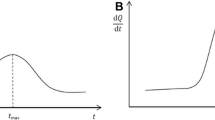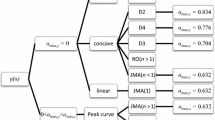Abstract
The famous Kissinger’s kinetic evaluation method (Anal. Chem. 1957) is examined with respect to: a) the relation between the DTA signal θ (t) and the reaction rate r(t) ≡ dα/dt; b) the requirements on reaction mechanism model f(α); and c) the relation of starting kinetic equation to the equilibrium behavior of sample under study. Distorting effect of heat inertia and difference between the temperature T p of extreme DTA deviation and the temperature T m at which the reaction rate is maximal are revealed. The kinetic equations respecting the influence of equilibrium temperature T eq , especially fusion temperature T f , are tested as bases for a modified Kissinger-like evaluation of kinetics.
Similar content being viewed by others
References
Standard Test Method for Arrhenius Kinetic Constants for Thermally Unstable Materials by Differential Scanning Calorimetry Using Kissinger Method, West Conshohocken, Pennsylvania, United States: American Society for Testing and Materials (ASTM) International, 2001.
Murray, P. and White, J., Kinetics of the thermal decomposition of clay: Part 4. Interpretation of DTA to thermal analysis of clays, Trans. Br. Ceram. Soc., 1955, vol. 54, pp. 204–237.
Šesták, J., Review of kinetic data evaluation from nonisothermal and isothermal data, Silikaty (Prague), 1967, vol. 11, pp. 153–190.
Šesták, J., Science of Heat and Thermophysical Studies: A Generalized Approach to Thermal Analysis, Amsterdam, The Netherlands: Elsevier, 2005.
Kissinger, H.E., Variation of peak temperature with heating rate in differential thermal analysis, J. Res. Natl. Bur. Stand., 1956, vol. 57, pp. 217–221.
Kissinger, H.E., Reaction kinetics in differential thermal analysis, Anal. Chem., 1957, vol. 29, pp. 1702–1706.
Matusita, K. and Sakka, S., Kinetic study of crystallization by DTA: Criterion and application of Kissinger plot, J. Non-Cryst. Solids, 1978, vol. 39, pp. 741–746.
Matusita, K. and Sakka, S., Kinetic study of crystallization of glass by differential thermal analysis-Criterion on application of Kissinger plot, Phys. Chem. Glasses, 1979, vol. 20, pp. 81–84.
Augis, J.A. and Bennet, J.E., Calculation of Avrami parameters for heterogeneous solid-state reactions using a modification of Kissinger method, J. Therm. Anal., 1978, vol. 13, pp. 283–292.
Balarin, M., Is Kissinger’s rule true? Thermochim. Acta, 1979, vol. 33, pp. 341–343.
Boswell, P.G., On the calculation of activation energies using a modified Kissinger method, J. Therm. Anal., 1980, vol. 18, pp. 353–358.
Elder, J.P., The general applicability of the Kissinger equation in thermal analysis, J. Therm. Anal., 1985, vol. 30, pp. 657–669.
Criado, J.M. and Ortega, A., Nonisothermal transformation kinetics in relation to Kissinger method, J. Non-Cryst. Solids, 1988, vol. 87, pp. 302–311.
Llópiz, J., Romero, M.M., Jerez, A., and Laureiro, Y., Generalization of the Kissinger equation for several kinetic models, Thermochim. Acta, 1995, vol. 256, pp. 205–211.
Sánchez-Jiménez, P.E., Criado, J.M., Pérez-Maqueda, L.A., Kissinger kinetic analysis of data obtained under different heating schedule, J. Therm. Anal. Calorim., 2008, vol. 94, pp. 427–432.
Agresti, F., An extended Kissinger equation for near-equilibrium solid-gas heterogeneous transformations, Thermochim. Acta, 2013, vol. 566, pp. 214–217.
Mehta, M. and Kumar, A., Applicability of Kissinger relation in the determination of activation energies of glass transition processes, J. Optoelectron. Adv. Mater., 2007, vol. 7, pp. 1473–1478.
Soliman, A.A., Derivation of the Kissinger equation for non-isothermal glass transition peaks, J. Therm. Anal. Calorim., 2005, vol. 89, pp. 389–392.
Budrugeac, P. and Segal, E., Applicability of the Kissinger equation in thermal analysis, J. Therm. Anal. Calorim., 2007, vol. 88, pp. 703–707.
Yi, C., Yanchun, L., and Yunlong, H., Supplement on applicability of the Kissinger equation in thermal analysis, J. Therm. Anal. Calorim., 2010, vol. 102, pp. 605–608.
Koga, N. and Criado, J.M., Application of the Kissinger method to solid-state reactions with a particle size distribution, J. Min. Metall., Sect. B, 1999, vol. 35, nos. 2–3, pp. 171–185.
Budrugeac, P., The Kissinger law and the IKP method for evaluating the non-isothermal kinetic parameters, J. Therm. Anal. Calorim., 2007, vol. 89, pp. 143–151.
Roura, P. and Farjas, J., Analytical solution for the Kissinger equation, J. Mater. Res., 2009, vol. 24, pp. 3095–3098.
Mouchina, E. and Kaisersberger, E., Temperature dependence of the time constants for deconvolution of heat flow curves, Thermochim. Acta, 2009, vol. 492, pp. 101–109.
Illeková, E., On the various activation energies at crystallization of amorphous metallic materials, J. Non-Cryst. Solids, 1984, vol. 68, pp. 153–160.
Šesták, J., Citation records and some forgotten anniversaries in thermal analysis, J. Therm. Anal. Calorim., 2012, vol. 109, pp. 1–5.
Šesták, J. and Berggren, G., Study of the kinetics of the mechanism of solid-state reactions at increasing temperature, Thermochim. Acta, 1971, vol. 3, pp. 1–12.
Šimon, P., Forty years of Šesták-Berggren equation, Thermochim. Acta, 2011, vol. 520, pp. 156–157.
Mianowski, A., The Kissinger law and isokinetic effect: Most common solution and thermokinetic equation, J. Therm. Anal. Calorim., 2004, vol. 74, pp. 955–973.
Illeková, E. and Šesták, J., Crystallization of metallic micro-, nano-, and non-crystalline glasses, in Thermal Analysis of Micro-, Nano-, and Non-Crystalline Materials, Šesták, J. and Šimon, P., Eds., Berlin: Springer-Verlag, 2013, chapter 13, pp. 257–290.
Šesták, J., Kozmidis-Petrović A., and Živković, Ž., Crystallization kinetics accountability and the correspondingly developed glass-forming criteria, J. Min. Metall., Sect. B, 2011, vol. 47, no. 2, pp. 229–239.
Koga, N., Šesták, J., and Šimon, P., Some fundamental and historical aspects of phenomenological kinetics in solid-state studied by thermal analysis, in Thermal Analysis of Micro-, Nano-, and Non-Crystalline Materials, Šesták, J. and Šimon, P., Eds., Berlin: Springer-Verlag, 2013, chapter 1, pp. 1–45.
Šesták, J., Nonisothermal kinetics by thermal analysis, in Science of Heat and Thermophysical Studies: A Generalized Approach to Thermal Analysis, Amsterdam, The Netherlands: Elsevier, 2005, chapter 11, pp. 318–343.
Svoboda, R., Čičmanec, P., Málek, J., Kissinger equation versus glass transition phenomenology, J. Therm. Anal. Calorim., 2013, vol. 114, pp. 285–293.
Šesták, J., Phenomenology of glass crystallization, in Kinetic Phase Diagrams: Nonequilibrium Phase Transitions, Chvoj, Z., Šesták, J., and Tříska, A., Eds., Amsterdam, The Netherlands: Elsevier, 1991.
Šesták, J., Rationale and fallacy of thermoanalytical kinetic patterns: How we model subject matter, J. Therm. Anal. Calorim., 2012, vol. 110, pp. 5–16.
Holba, P., Equilibrium background of processes initiated by heating and the Ehrenfest classification of phase transitions, in Thermal Analysis of Micro-, Nano-, and Non-Crystalline Materials, Šesták, J. and Šimon, P., Eds., Berlin: Springer-Verlag, 2013, chapter 2, pp. 29–52.
Holba, P. and Šesták, J., Kinetics with regard to the equilibrium of processes studied by non-isothermal techniques, Z. Phys. Chem. (Muenchen, Ger.), 1972, vol. 80, pp. 1–20.
Holba, P., Nevřiva, M., and Šesták, J., Utilization of DTA for the determination of heats of the transformation of solid-solutions Mn3O4-Mn2CrO4, Izv. AN SSSR, Neorg. Mater., 1974, vol. 10, pp. 2007–2008.
Holba, P., Nevřiva, M., and Šesták, J., Analysis of DTA curve and related calculation of kinetic data using computer technique, Thermochim. Acta, 1978, vol. 23, pp. 223–231.
Holba, P., Šesták, J., and Sedmidubsky, D., Heat transfer and phase transition at DTA experiments, in Thermal Analysis of Micro-, Nano-, and Non-Crystalline Materials, Šesták, J. and Šimon, P., Eds., Berlin: Springer-Verlag, 2013, chapter 5, pp. 99–134.
Šesták, J. and Holba, P., Heat inertia and temperature gradient in the treatment of DTA peaks existing on every occasion of real measurements but until now omitted, J. Therm. Anal. Calorim., 2013, vol. 113, pp. 1633–1643.
Vold, M.J., Differential thermal analysis, Anal. Chem., 1949, vol. 21, pp. 683–688.
Chen, R. and Kirsh, Y., Analysis of Thermally Stimulated Processes, Oxford: Pergamon Press, 1981, pp. 109–110.
Schultze, D., Differentialthermoanalyze, Berlin: VEB, 1969 [in German].
Smykats-Kloss, W., Differential Thermal Analysis, Berlin: Springer-Verlag, 1974.
Pope, M.I. and Judd, M.D., Differential Thermal Analysis, London: Heyden, 1977.
Höhne, G.W.H., Hemminger, W., and Flammersheim, H.J., Differential Scanning Calorimetry, Dortrecht, The Netherlands: Springer-Verlag, 2010.
Egunov, V.P., Vvedenie v termicheskii analiz (Introduction to Thermal Analysis), Samara: Samara State Technical University, 1996 [in Russian].
Borchard, H.J. and Daniels, F., The application of DTA to the study of reaction kinetics, J. Am. Chem. Soc., 1957, vol. 79, pp. 41–46.
Blumberg, A.A., DTA and heterogeneous kinetics: The reactions of vitreous silica with HF, J. Phys. Chem., 1959, vol. 63, pp. 1129–1132.
Piloyan, G.O., Vvedenie v teoriyu termicheskogo analiza (Introduction in the Theory of Thermal Analysis), Moscow: Nauka, 1964 [in Russian].
Piloyan, G.O., Ryabchikov, I.O., and Novikova, S.O., Determination of activation energies of chemical reactions by DTA, Nature, 1966, vol. 3067, p. 1229.
Boerio-Goates, J. and Callen, J.E., in Differential Thermal Methods: Chapter. Determination of Thermodynamic Properties, Rossiter, B.W. and Beatzold, R.C., Eds., New York: Wiley, 1992, pp. 621–718.
Šesták, J., Differential thermal analysis, in Thermophysical Properties of Solids: A Theoretical Thermal Analysis, Amsterdam, The Netherlands: Elsevier, 1984, chapter 12. Translated under the title Teoriya termicheskogo analiza, Moscow: Mir, 1988, pp. 312–350.
Vyazovkin, S., Is the Kissinger equation applicable to the processes that occur on cooling? Macromol. Rapid Commun., 2002, vol. 23, pp. 771–775.
Sunol, J.J., Berlanga, R., Clavaguera-Mora, M.T., and Clavaguera, N., Modelling crystallization processes and transformation diagrams, Acta Mater., 2002, vol. 50, pp. 4783–4790.
Turnbull, D., Under what conditions can a glass be formed? Contemp. Phys., 1969, vol. 10, pp. 473–488.
Author information
Authors and Affiliations
Corresponding author
Additional information
The article is published in the original.
Rights and permissions
About this article
Cite this article
Holba, P., Šesták, J. Imperfections of Kissinger evaluation method and crystallization kinetics. Glass Phys Chem 40, 486–495 (2014). https://doi.org/10.1134/S1087659614050058
Received:
Published:
Issue Date:
DOI: https://doi.org/10.1134/S1087659614050058




